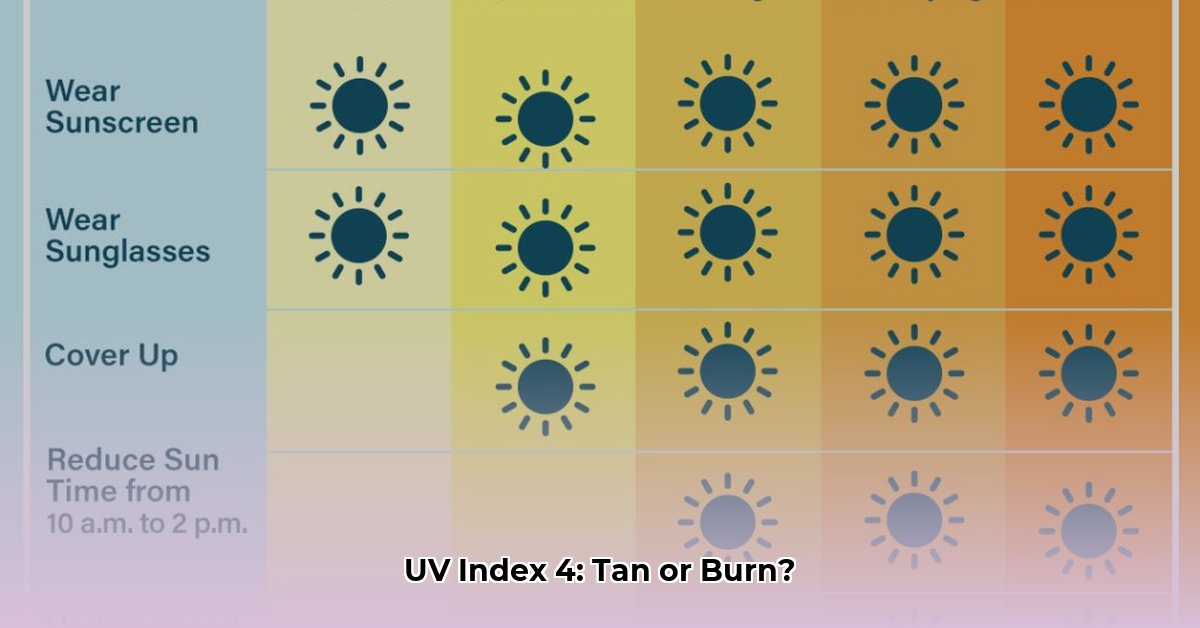Yes, you can tan at a UV index of 4, but it’s essential to do so safely. This comprehensive guide explains the UV index, outlines safe tanning practices, and addresses common concerns about sun exposure.
Understanding the UV Index
The UV index measures the strength of the sun’s ultraviolet (UV) radiation. It ranges from 0 to 11+, with higher numbers indicating greater intensity and risk of skin damage. A UV index of 4 falls within the “moderate” range. This means the sun’s rays are strong enough to produce a tan, but precautions are still necessary to prevent sunburn and long-term skin damage. The UV index fluctuates throughout the day, peaking between 10 a.m. and 4 p.m. It also varies by location, season, and altitude.
Safe Tanning at UV Index 4: A Step-by-Step Guide
Tanning at a UV index of 4 is possible, and might even be preferable to tanning at higher indexes as it’s gentler on your skin. While it may take 2-3 days to develop a noticeable tan, this slower pace reduces the risk of sunburn. Here’s how to do it safely:
Step 1: Sunscreen – Your First Line of Defense
Apply a broad-spectrum sunscreen with an SPF of 30 or higher at least 15-20 minutes before sun exposure. Broad-spectrum protection shields your skin from both UVA and UVB rays. Reapply every two hours, or immediately after swimming or sweating.
Step 2: Gradual Exposure – Acclimate Your Skin
Start with short sun exposure sessions (15-20 minutes) and gradually increase the duration as your skin adapts. This allows your skin to build a natural defense against the sun’s rays.
Step 3: Time of Day – Avoid Peak Sun Hours
Limit sun exposure between 10 a.m. and 4 p.m., when UV radiation is most intense.
Step 4: Protective Clothing & Shade – Your Sun Allies
Wear protective clothing such as wide-brimmed hats, sunglasses, and long-sleeved shirts. Seek shade whenever possible, especially during peak sun hours.
Step 5: Hydration – Inside and Out
Drink plenty of water to stay hydrated, especially when spending time in the sun. Dehydration can make your skin more susceptible to sunburn.
Step 6: After-Sun Care – Soothe and Replenish
Apply a moisturizing after-sun lotion to soothe and hydrate your skin after sun exposure. This can help minimize peeling and dryness.
Risks of Sun Exposure at UV Index 4
Even at a moderate UV index, sun exposure carries risks. Sunburn, the most immediate concern, can occur even on cloudy days as UV rays can penetrate cloud cover. Repeated sunburns increase the risk of premature aging (wrinkles, age spots) and skin cancer.
Factors Influencing Tanning Time
Several factors affect how quickly you tan, including:
- Skin Type: Fair-skinned individuals tend to burn more easily and tan less quickly than those with darker skin tones.
- Altitude: UV radiation intensifies at higher altitudes.
- Time of Day: UV radiation is strongest between 10 a.m. and 4 p.m.
- Cloud Cover: While clouds offer some protection, they don’t completely block UV rays.
- Reflection: Surfaces like water, sand, and snow can reflect UV rays, increasing exposure.
UVA vs. UVB Rays
UVA rays penetrate deeper into the skin, contributing to premature aging and wrinkles. UVB rays primarily cause sunburn. Both UVA and UVB rays can lead to skin cancer.
Tanning Beds vs. Natural Sunlight
Tanning beds emit concentrated UV radiation, significantly increasing the risk of skin cancer. Natural sunlight, enjoyed responsibly with appropriate precautions, is a much safer way to tan.
Frequently Asked Questions (FAQ)
- Can I use sunscreen with a lower SPF than 30 at a UV index of 4? Lower SPF sunscreens offer some protection, but SPF 30 or higher is recommended for optimal defense. Reapply more frequently if using a lower SPF.
- What if I get sunburned at a UV index of 4? Treat the burn with cool compresses and aloe vera. Over-the-counter pain relievers can help with discomfort. Avoid further sun exposure until the burn heals. Seek medical attention for severe sunburns.
UV Index Guide & Tanning Time Estimates
| UV Index Level | Description | Recommended Exposure Time for Fair Skin |
|---|---|---|
| 0-2 | Low | 30-60 minutes |
| 3-5 | Moderate | 15-20 minutes initially, gradually increasing |
| 6-7 | High | 10-15 minutes initially, limit prolonged exposure |
| 8-10 | Very High | Limit exposure to a few minutes, seek shade |
| 11+ | Extreme | Avoid sun exposure altogether |
Please note that these are estimates. Individual tanning times may vary.
Conclusion
Tanning at a UV index of 4 is possible, but prioritize sun safety. By following these guidelines, you can enjoy the sun while minimizing the risks of sunburn and long-term skin damage. Consulting a dermatologist is always recommended for personalized sun protection advice.
- Wellness Fair Ideas for Work to Boost Employee Wellbeing - December 15, 2025
- Affordable Employee Wellness Fair Ideas for Any Budget - December 14, 2025
- Employee Wellness Programs Strategically Benefit Employee Health And Retention - December 13, 2025
















